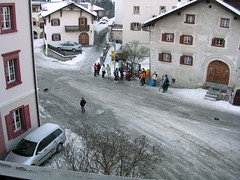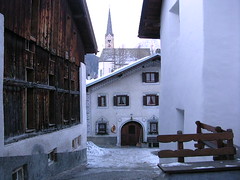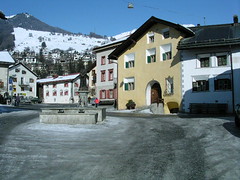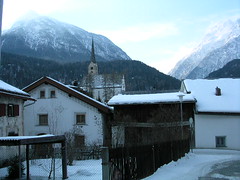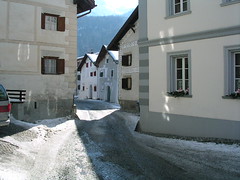When I opened my New York Times yesterday I read, to my surprise, that
Sara Stein had died, on February 25.
A fellow town resident, a friendly acquaintance, and a naturalist and writer whom I respected, Sara Stein was notable to me not just for having converted her six-acre property into a naturalistic garden of native plants and for writing about it in
Noah's Garden and other books, but for the completely practical, unsentimental way she went about her business.
She was the first one I knew of, for example, to point out that local tree protection ordinances might make us feel good and they might protect big trees, but they did nothing to prevent anyone from cutting down or pulling out everything that lived beneath and between the trees, and therefore did nothing to protect the larger, more complex ecosystem that we were all concerned about – namely, the woods.
I once told her that my wife and I had looked at and seriously considered buying a very interesting contemporary house near us that, as we learned during the course of our deliberations, had been designed by her husband, Martin, and lived in happily for a number of years by Sara, Martin and their young children.
Ultimately there were several things about the place that prevented us from laying out the $480,000 that the owner was asking, but chief among them were the dense oak and laurel woods around it.
We wanted to put in a garden. “It was too much in the woods, too closed-in for us,” I told her.
“That’s why we moved too,” she told me.
They moved across town more than 25 years ago, to a house that I believe Martin designed as well – and put in a garden they did, although Sara wrote that at first it was more akin to farming than to gardening. I visited her there once, on a glorious autumn afternoon about seven years ago. Their six acres were bordered by a strip of woods, through which she and her husband had erected a deer fence that rose from the ground at a 45-degree angle, a design that was far less visually intrusive than a big ugly deer fence and, she said, just as effective in keeping out the baffled deer. The driveway was short but it wound up to the house, which was pleasant but not as aggressively contemporary as the one we had considered buying.
Her household was busy -- my recollection is that one of her four sons was getting married that weekend, and people were buzzing about, including Martin. I was there to talk to her about deer and their affect on the local ecosystem for a newspaper article I was writing, and we sat at a small table in her kitchen, she rolling a cigarette and smoking it as I asked questions. She was small and bespectacled, with no-nonsense graying hair and what seemed to me an impressive knowledge of local botany.
Because their property and all the work that she and Martin had done to it would have been reduced to nothing had deer been allowed in, we walked around to see what they had accomplished.
Most notably, there was no lawn. The landscape was like a quilt of colors and textures – asters, ironweed, coneflowers, goldenrods, bluestem grasses (I'm reciting from memory rather than notes) – sloping to a pond that they had had dredged.
Practical and unsentimental: She told me that before planting, they had rid the property of invasives and other unwanted plants by spreading a herbicide, as shocking to environmentalist orthodoxy as encroaching on a wetland. She added though that she would recommend only a glyphosate herbicide, which was not persistent and was less toxic than others and therefore acceptable.
After that, they burned – controlled grass fires once every three years: In her mind it was particulates, soot, and global warming gases versus gasoline-powered mowers, blowers and weed-whackers, and chemical fertilizers.
“I agree,” she wrote in Noah’s Garden, “that the perfume of burning autumn leaves and the thrill of bonfires in the winter are pleasures too light to outweigh medical and environmental caution, and leaves are better used for compost, brush better chipped for mulch or stacked tidily to decay in place. But everything considered, I’m not sure that grass fires and the ecosystems they maintain don’t outweigh the environmental onus of the lawns prairie plantings usually replace.”
She was proud of their property, and indeed was an active proselytizer for planting native vegetation, but she was under no illusion that she and Martin had recreated an ecosystem that was in any way native to this part of New York. On the contrary. What they had created was closer to a tallgrass a prairie. But it was a prairie with bluebirds and butterflies and hummingbird moths and an astonishing number of other creatures.
I make no claim to having been close friends with Sara Stein. After my visit to her house, we saw each other only three or four times. Our most recent encounter was last May at a cocktail party in town that was too crowded for much comfortable conversation except for a quick hello as she smoked one of her hand-rolled cigarettes.
Once I invited her to explore a tract of hemlock gorge that our town was interested in preserving. Its beauty impressed her and she wondered aloud if maybe she and Martin should buy it and establish a small family compound on it – something they were thinking of doing in Maine, I believe, where they had a cottage on a tidal inlet (the Times said she died at her home in Vinalhaven, Maine).
In Noah’s Garden she wrote that prairie plants grow down, establishing deep roots, before they look like much of anything above ground.
“Curious to see if magic were happening yet, I dug down one day three years after grass had first germinated in the clay. I found an earthworm. But my eager human rhythm was out of step with grassland time, and my vision was insufficiently nearsighted. I couldn’t see that much was happening. Let my grandchildren dig the hillside at my age, though, and they’ll see a topping of good earth
“What else will they see, will they point out to their grandchildren? Will they see the walking stick that I knew in childhood but that hasn’t yet returned? Will they be startled by the noisy flight of red-legged grasshoppers whose legs kick hard enough to hurt and who spit brown drops like chewed tobacco? I see meadowlarks, but there aren’t any bobolinks yet. I look in vain for the green grass snakes of my childhood.”
When I drove past her house in town this morning, the name on the mailbox still said “Stein,” the deer fence was intact, the driveway gate shut, and the prairie covered with hard, bright snow.



